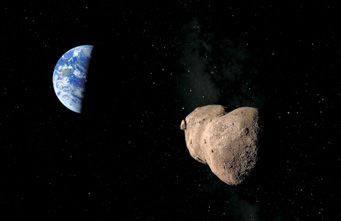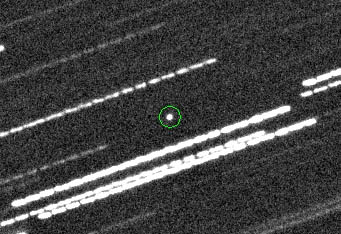Every so often, Earth is hit by a small chunk of asteroid that self-destructs harmlessly in its atmosphere. Fortunately, for the moment all the beefier asteroidal bodies in Earth's vicinity seem to be whizzing by harmlessly — planetary astronomers continue to tell us that no known body has a significant chance of hitting home for the foreseeable future.

On Friday the 13th in April 2029, a 900-foot-wide asteroid named Apophis will pass close enough to Earth (about 25,000 miles) to briefly appear as a 3rd-magnitude star in the night sky.
Dan Durda
The one known body that has been causing them a little late-night heartburn is 99942 Apophis. Roughly 900 feet (270 meters) across, Apophis is big and massive enough to do some real damage here, walloping us with the explosive equivalent of 5 megatons of TNT.
NASA's number-crunchers have found that it has a 1-in-45,000 chance of striking Earth on April 13, 2036. But that mildly unsettling prediction hadn't been updated since 2006, and yesterday the Minor Planet Center issued recent observations and a new orbit.
Apparently we can all breath a little easier. This morning I heard JPL dynamicist Steven Chesley announce that the chance of an impact has dropped to something like 1-in-250,000.
But we're not completely out of the woods. The new computations also reveal a comparable impact risk on the same date in 2068 — and for now there's no way to rule that one out. Says Chesley, "2068 is the new 2036."
The problem is that when asteroids rotate, their orbits change due to a subtle phenomenon, called the Yarkovsky effect, whose consequences for impact predictions have only recently been appreciated. Spin an asteroid one way, and its orbit gets bigger; spin it the other way, and the orbit gets smaller.

It took a stack of about 30 images and an 88-inch telescope to record this view of the little asteroid 99942 Apophis on December 25, 2006.
David J. Tholen / Univ. of hawaii
We don't know which way Apophis is spinning, but observers are sure eager to find out! David Tholen (University of Hawaii), who's followed this body intently with the 88-inch telescope atop Mauna Kea, thinks he'll have a good shot at getting the answer next May. If that doesn't pan out, Apophis will come within 10 million miles of Earth in January 2013 — close enough (but not too close) for radar ranging to do the job.
If all else fails, we'll have an especially good view of this little interloper in April 2029, when it'll pass just 25,000 miles from us (not much higher than the orbits of geosynchronous satellites). Don't worry: Chesley assures us that there's no chance of an impact then.
 2
2









Comments
C.M. Carlisle
October 9, 2009 at 1:06 pm
Apophis just came up in my planetary science class yesterday, how ironic . . .
You must be logged in to post a comment.
Glenn Jolly
October 10, 2009 at 11:16 am
Kelly,
I think you mean to say 500 megatons for the impact energy. Only 5 megatons would be a Tunguska class event. Fortunately it does not look like its going to happen, at least this time around.
You must be logged in to post a comment.
You must be logged in to post a comment.